
Student Achievement Disclosure Information

Full-Time Retention Rate:
Measured by the percentage of full-time, first-time degree/certificate-seeking students from the previous summer/fall who either re-enrolled or successfully completed their program by the current fall. HCTC's threshold is to meet or exceed the median full-time retention rate for its comparison group. HCTC's target strategy is to increase its full-time retention rate by one percentage point over HCTC's prior year full-time retention rate. Data provided by the U.S. Department of Education Integrated Postsecondary Education Data System (IPEDS) in HCTC's annual IPEDS Data Feedback Report.
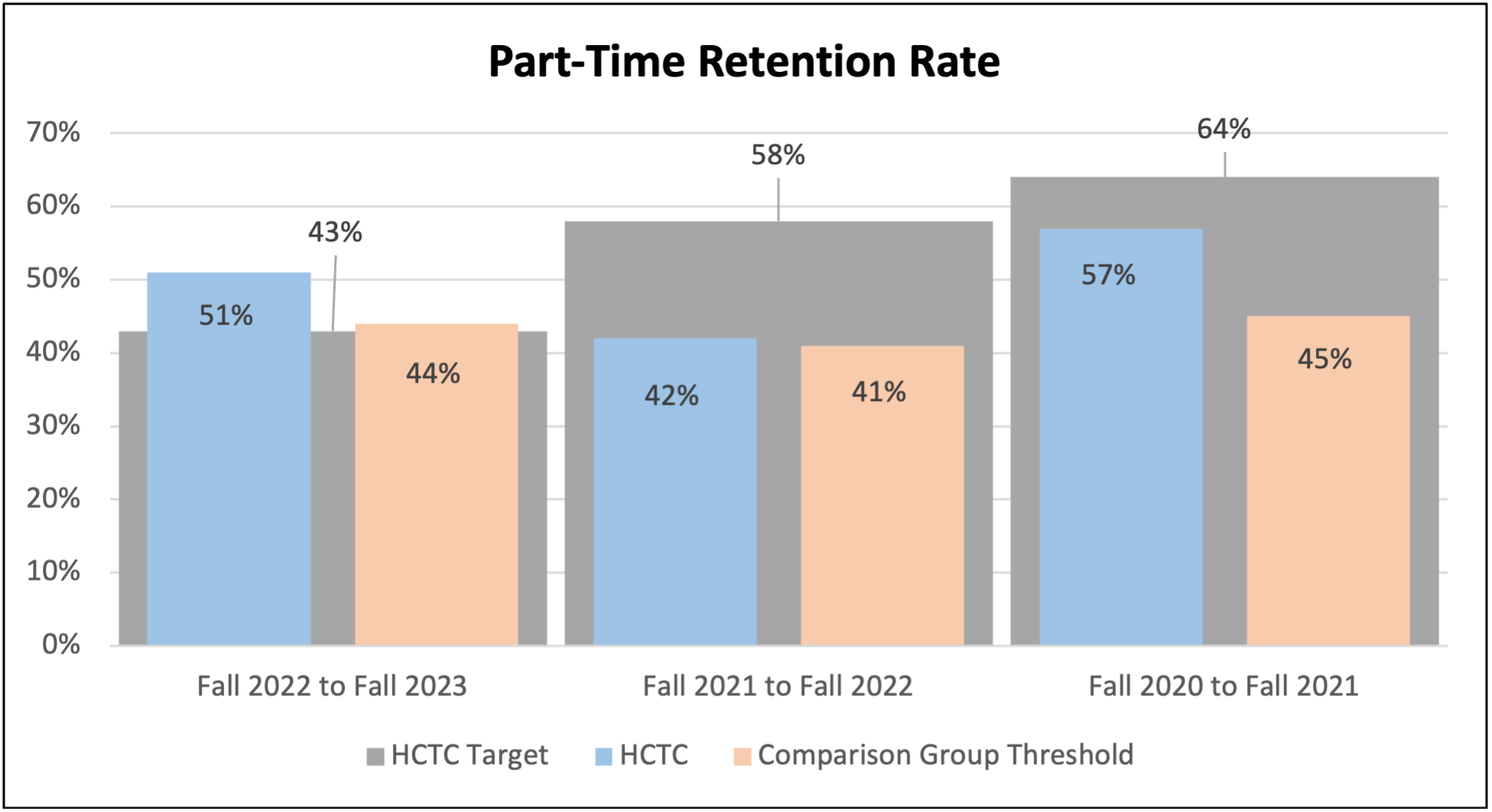
Part-Time Retention Rate:
Measured by the percentage of part-time, first-time degree/certificate-seeking students from the previous summer/fall who either re-enrolled or successfully completed their program by the current fall. HCTC's threshold is to meet or exceed the median full-time retention rate for its comparison group. HCTC's target strategy is to increase its part-time retention rate by one percentage point over HCTC's prior year part-time retention rate. Data provided by the U.S. Department of Education Integrated Postsecondary Education Data System (IPEDS) in HCTC's annual IPEDS Data Feedback Report.
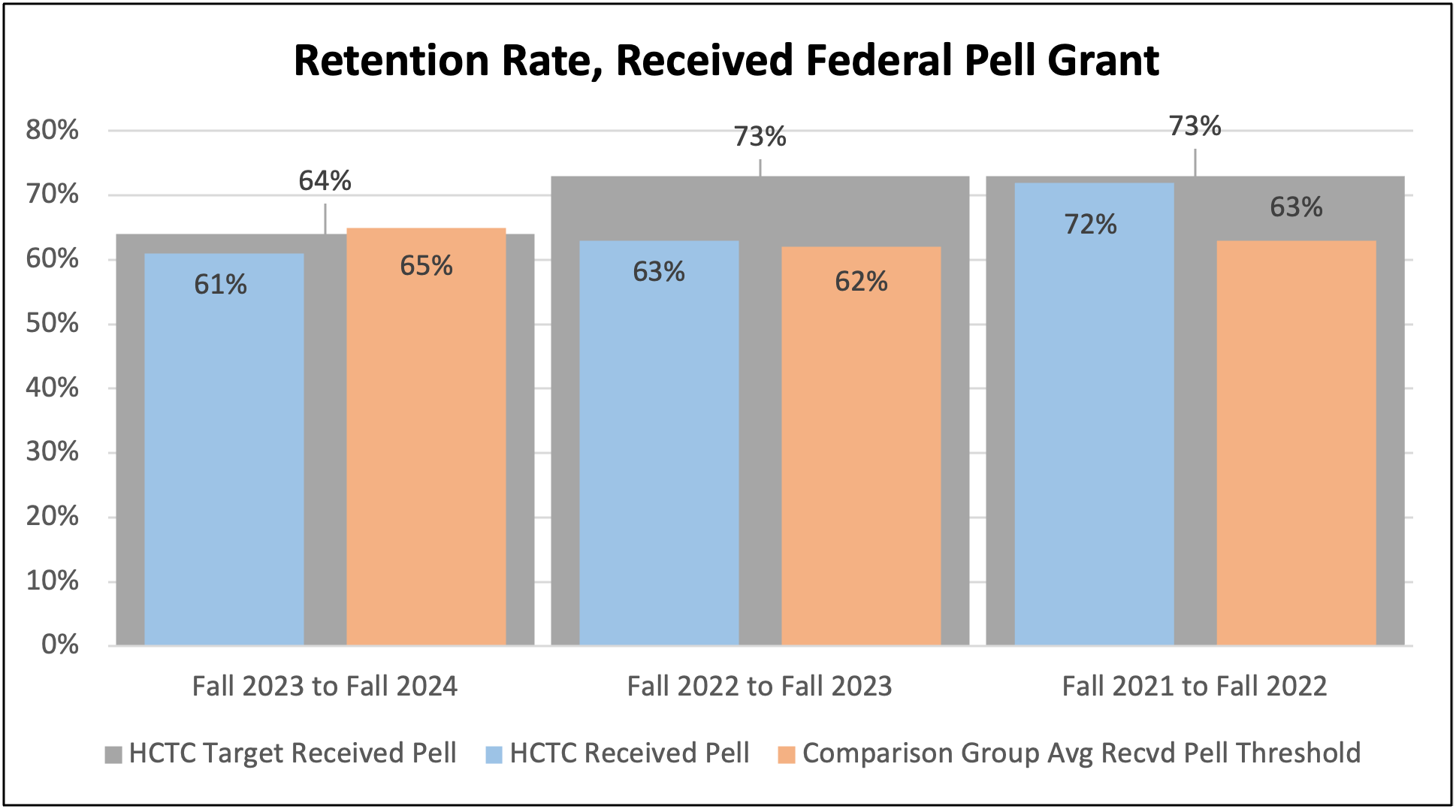
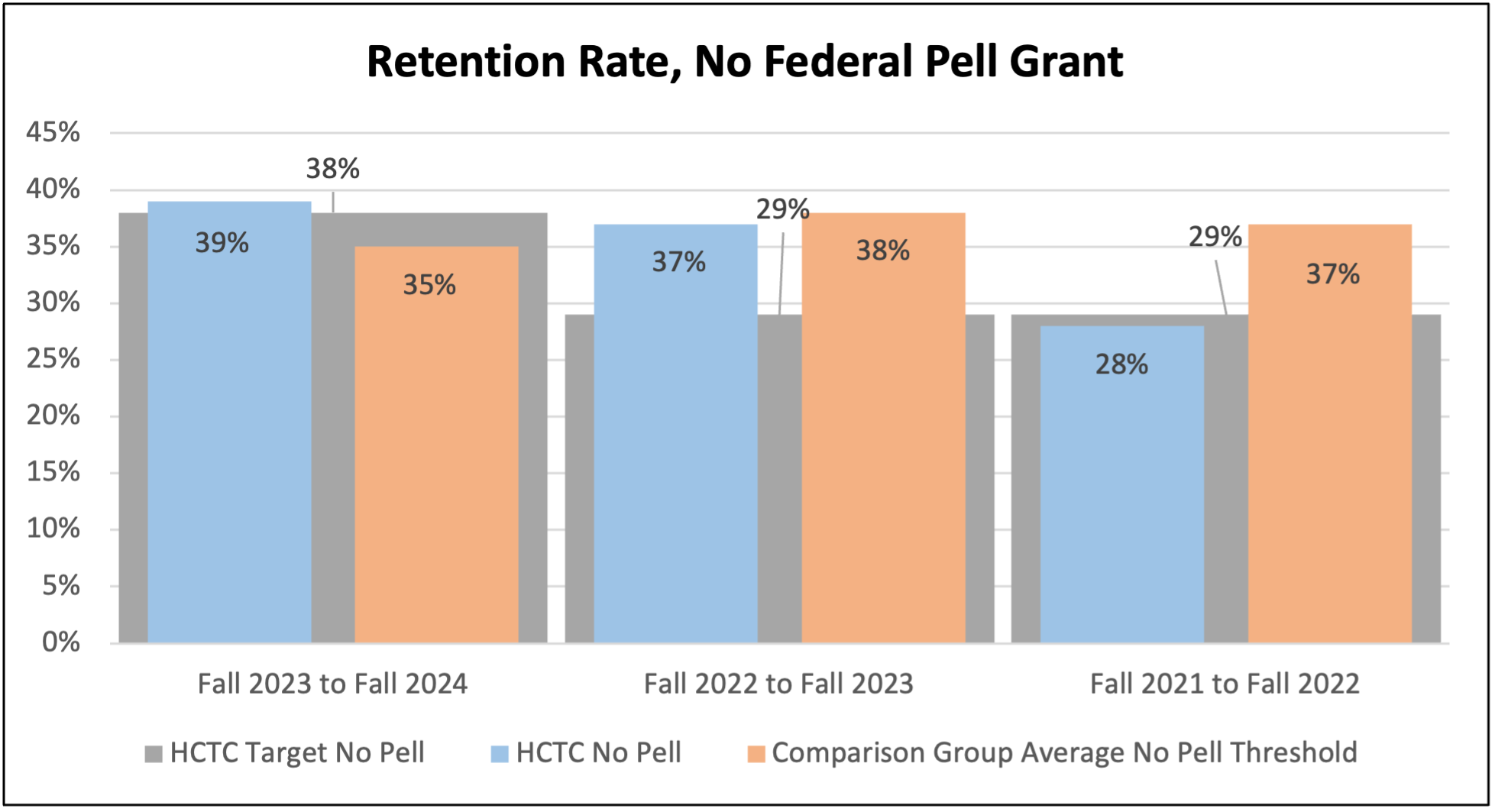
Retention Rate Received Pell vs. Did Not Receive Pell:
Measured by the percentage of first-time credential-seeking students from the previous summer/fall who either re-enrolled or successfully completed their program by the current fall disaggregated by students who received a federal Pell grant vs. students who did not receive a federal Pell grant. HCTC's threshold is to meet or exceed the median retention rate for students who received a federal Pell grant vs. students who did not receive a federal Pell grant for its comparison groups. HCTC's target strategy is to increase its retention rate for students who received a federal Pell grant vs students who did not receive a federal Pell grant by one percentage point over HCTC's prior year retention rate. First-time, credential-seeking cohort data is as reported to the U.S. Department of Education Integrated Postsecondary Education Data System (IPEDS). Data provided by the KCTCS Office of Research and Policy Analysis.

Graduation Rate:
Measured by the percentage of students from the cohort who completed a degree or certificate within three years. That cohort includes full-time, first-time degree-certificate-seeking students. HCTC's threshold is to meet or exceed the median graduation rate for its comparison group. HCTC's target strategy is to increase its graduation rate by one percentage point over HCTC's prior year graduation rate. Data provided by the U.S. Department of Education Integrated Postsecondary Education Data System (IPEDS) in HCTC's annual IPEDS Data Feedback Report.
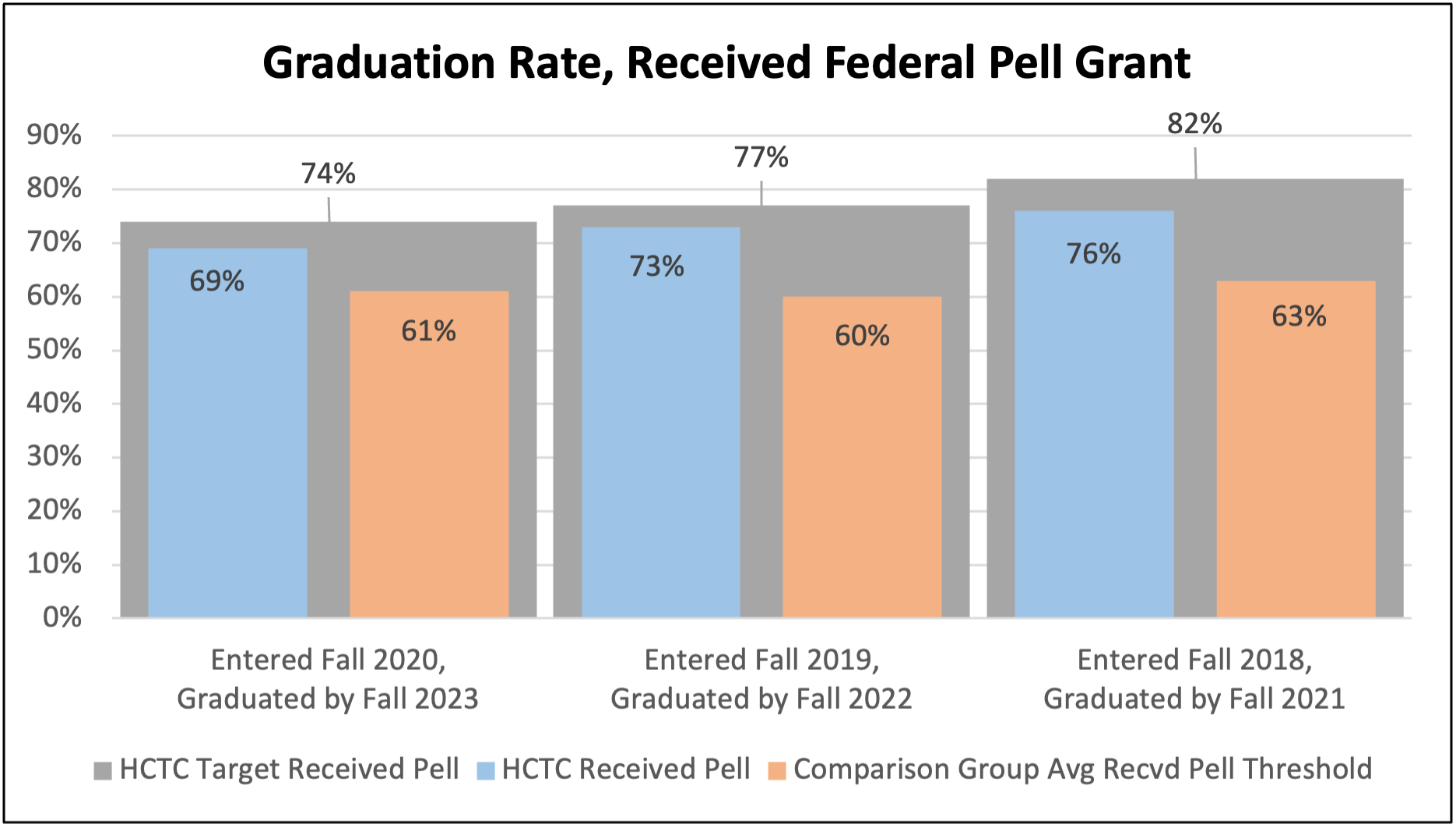
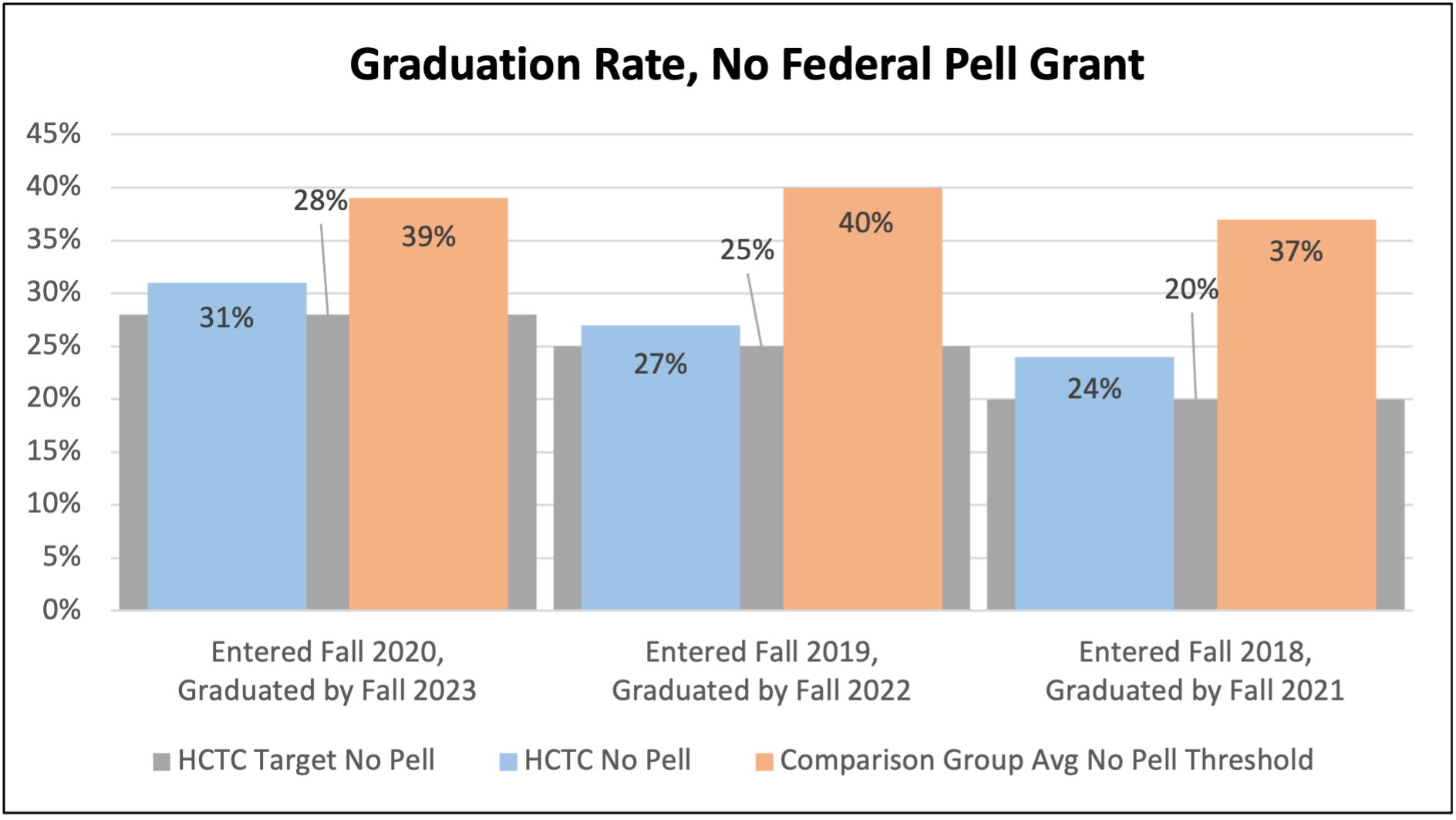
Graduation Rate Received Pell vs. Did Not Receive Pell:
Measured by the percentage of students from the cohort who completed a degree or certificate within three years disaggregated by students who received a federal Pell grant vs. students who did not receive a federal Pell grant. That cohort includes first-time, full-time, credential-seeking students from summer-fall. HCTC's threshold is to meet or exceed the median graduation rate for its comparison group. HCTC's target strategy is to increase its graduation rate for students who received a federal Pell grant vs students who did not receive a federal Pell grant by one percentage point over HCTC's prior year graduation rate. Data provided by the U.S. Department of Education Integrated Postsecondary Education Data System (IPEDS) in HCTC's annual IPEDS Data Feedback Report, and data provided by the KCTCS Office of Research and Policy Analysis.
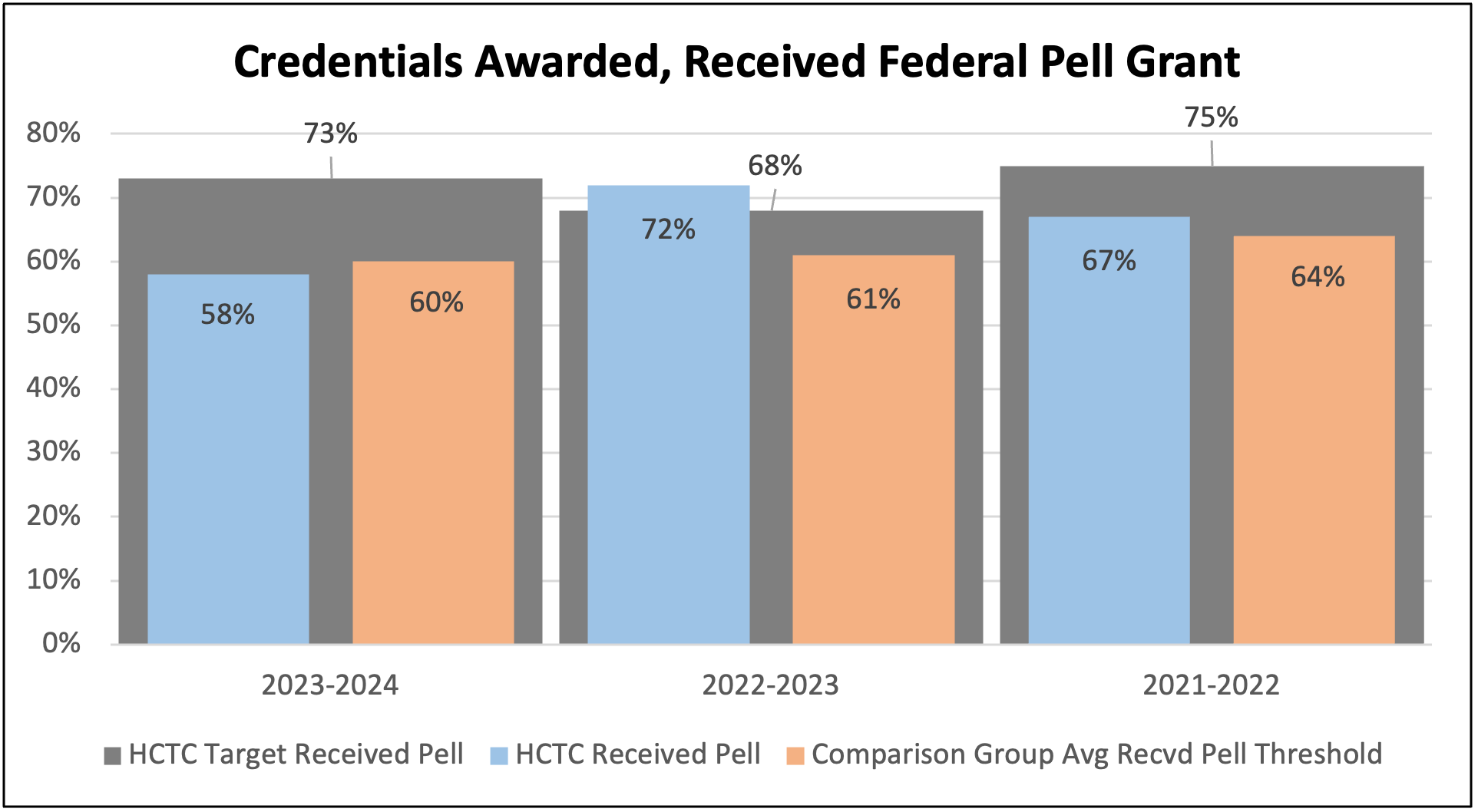

Credentials Awarded Received Pell vs. Did Not Receive Pell:
Measured by the total number of credentials (degrees, diplomas, and certificates) awarded for the academic year disaggregated by students who received Pell vs. students who did not receive a federal Pell grant. HCTC's threshold is to meet or exceed the median total credentials awarded--Received Federal Pell Grant vs. Did Not Receive Federal Pell Grant for its comparison groups. HCTC's target strategy is to increase its number of credentials awarded for students who received a federal Pell grant vs students who did not receive a federal Pell grant by one percentage point over HCTC's prior year number of credentials awarded. Data provided by the KCTCS Office of Research and Policy Analysis.

Credentials Awarded :
Measured by the total number of credentials (degrees, diplomas, and certificates) awarded for the academic year. HCTC's threshold is to meet or exceed the median total credentials awarded for its comparison group. HCTC's target strategy is to increase its number of credentials awarded by one percentage point over HCTC's prior year number of credentials awarded. Data provided by the KCTCS Office of Research and Policy Analysis.
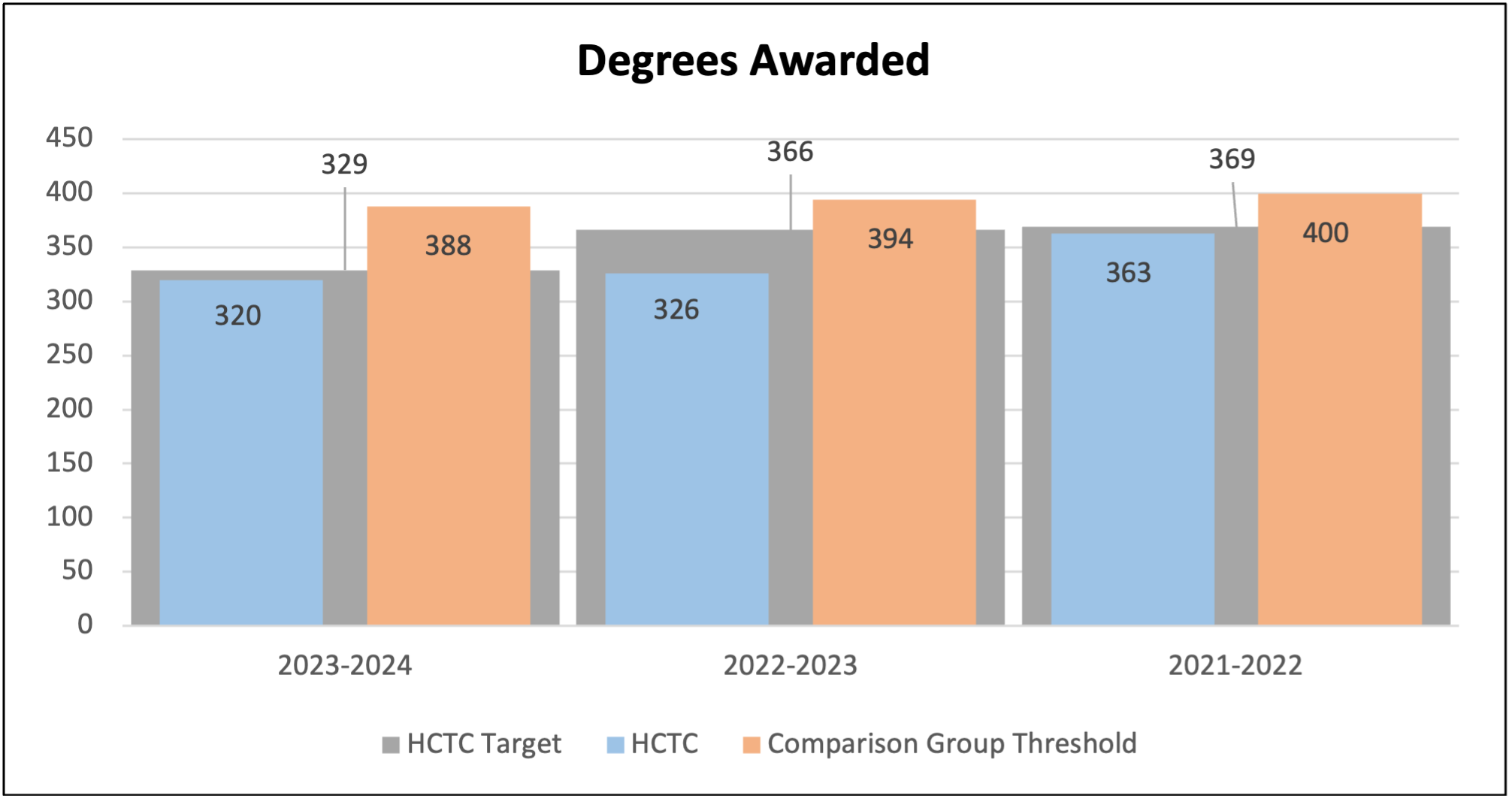
Degrees Awarded:
Measured by the total number of degrees awarded for the academic year. HCTC's threshold is to meet or exceed the median total degrees awarded for its comparison group. HCTC's target strategy is to increase its number of degrees awarded by one percentage point over HCTC's prior year number of degrees awarded. Data provided by the KCTCS Office of Research and Policy Analysis.
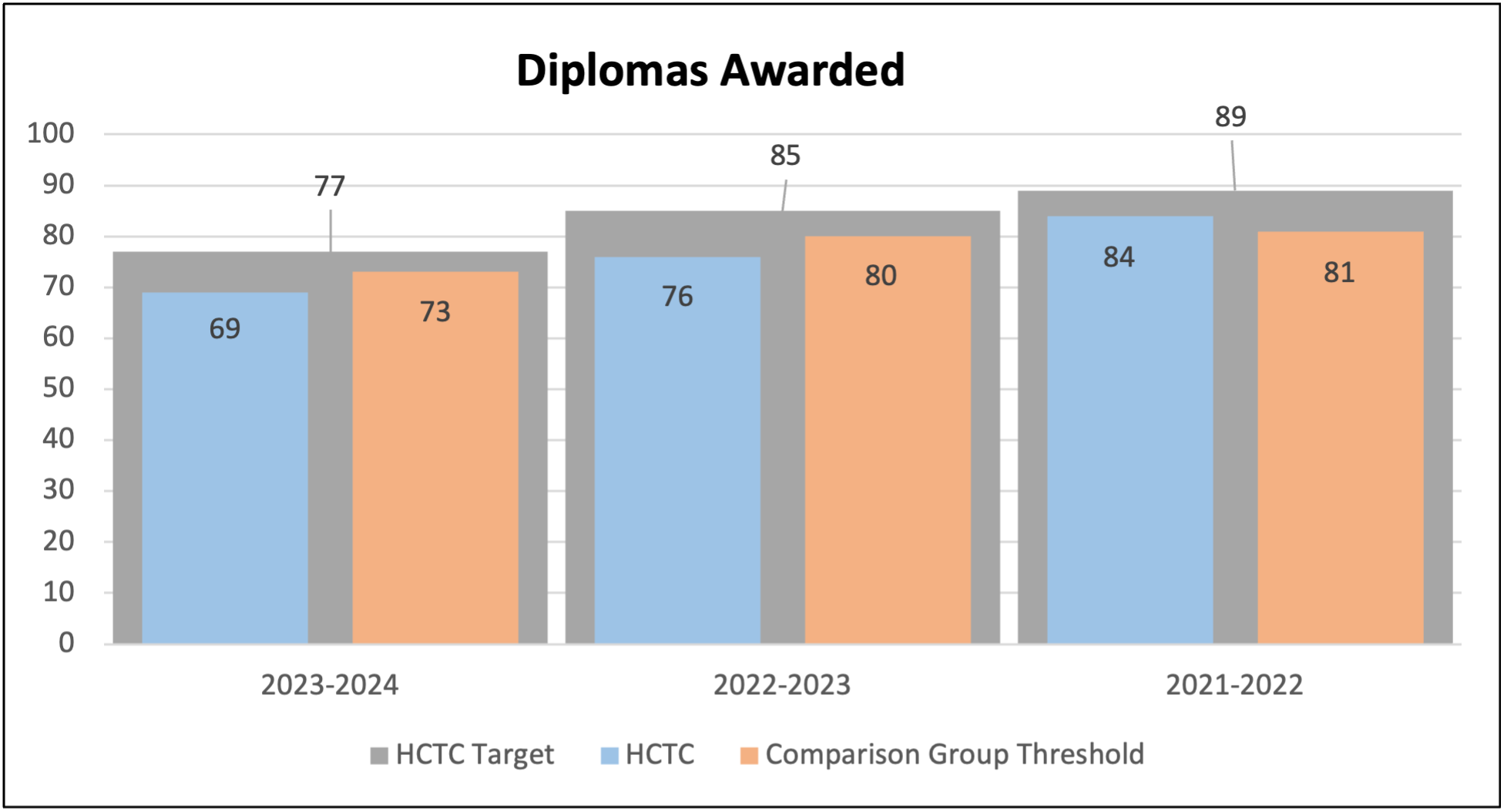
Diplomas Awarded:
Measured by the total number of diplomas awarded for the academic year. HCTC's threshold is to meet or exceed the median total diplomas awarded for its comparison group. HCTC's target strategy is to increase its number of diplomas awarded by one percentage point over HCTC's prior year number of diplomas awarded. Data provided by the KCTCS Office of Research and Policy Analysis.
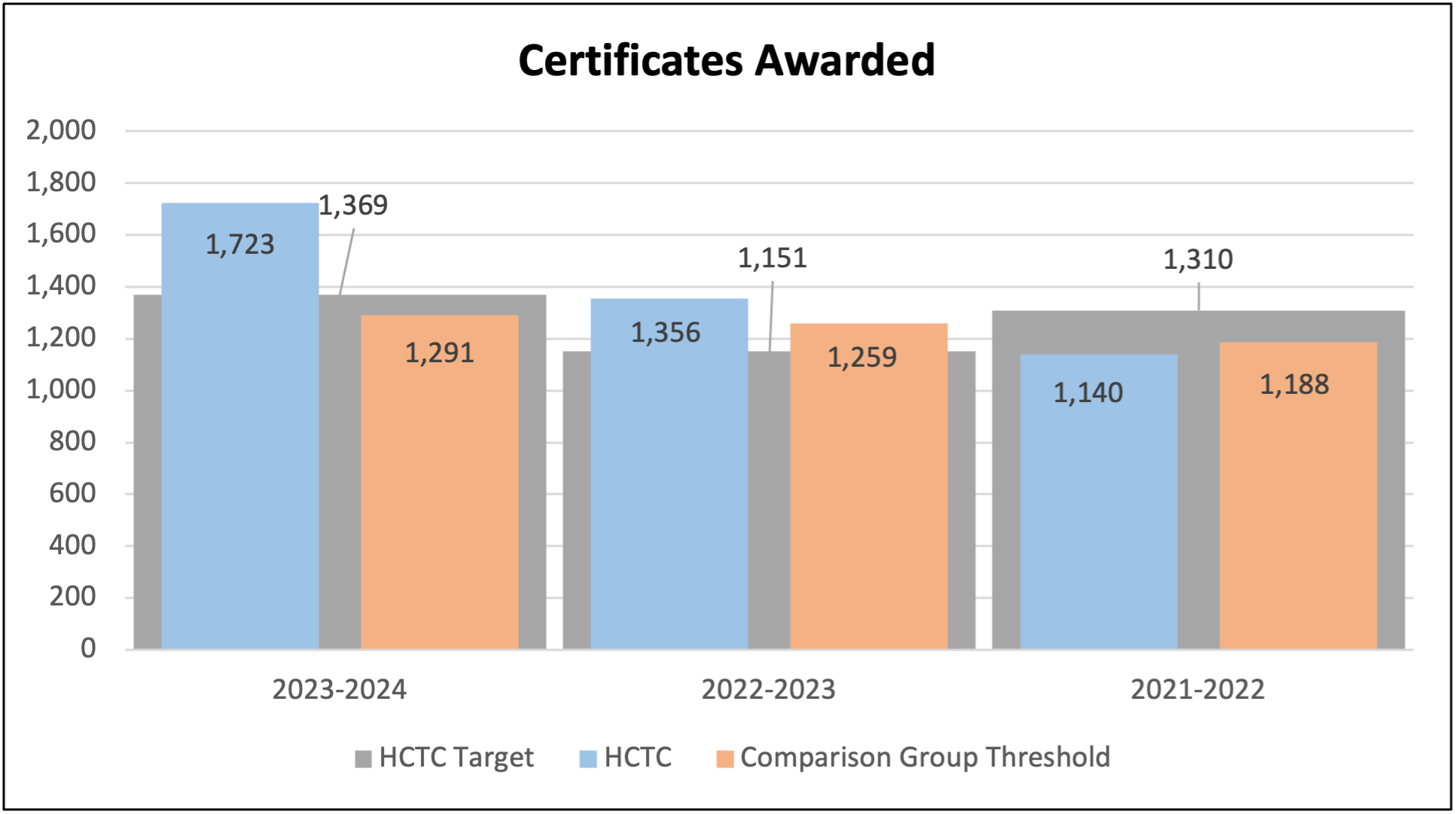
Certificates Awarded:
Measured by the total number of certificates awarded for the academic year. HCTC's threshold is to meet or exceed the median total certificates awarded for its comparison group. HCTC's target strategy is to increase its number of certificates awarded by one percentage point over HCTC's prior year number of certificates awarded. Data provided by the KCTCS Office of Research and Policy Analysis.

Associate Degree Graduates Who Transfer Within One Year:
Measured by the percentage of associate degree graduates in the academic year who enrolled at a four-year institution by the academic year after the term end date of the term the first associate degree was earned, or in the next academic year. HCTC's threshold is to meet or exceed the median associate degree graduates who transfer within one year for its comparison group. HCTC's target strategy is to increase its number of associate degree graduates who transfer within one year by one percentage point over HCTC's prior year number of associate degree graduates who transferred within one year. Data provided by the KCTCS Office of Research and Policy Analysis.
To obtain at PDF version of this information please contact Lois Puffer, Coordinator of Institutional Research at lois.puffer@kctcs.edu
As an institution accredited by the Southern Association of Colleges and Schools Commission on Colleges (SACSCOC), Hazard Community and Technical College (HCTC) is obligated to provide to its students, constituents, and the public information about its goals for student achievement and the success of students in achieving those goals. HCTC’s information on student success includes reliable information on retention, graduation, credentials awarded, and transfer appropriate to institutional mission. Retention Rate, Graduation Rate, and Credentials Awarded have been disaggregated by students who received a federal Pell grant vs. students who did not receive a federal Pell grant. Each measure includes the most recent data available and a definition of the measure.
For all measures, HCTC's threshold is to meet or exceed the median per each metric for its comparison group. HCTC's target strategy is to increase by one percentage point over HCTC's prior year.
The peer comparison group is HCTC’s KCTCS Peer Institutions list of eight KCTCS colleges of similar enrollment size as HCTC:
- Ashland Community and Technical College
- Big Sandy Community and Technical College
- Henderson Community College
- Hopkinsville Community College
- Madisonville Community College
- Maysville Community and Technical College
- Owensboro Community and Technical College
- Southeast Kentucky Community and Technical College
Updated 4-7-2025
Lois Puffer
HCTC IR Director

